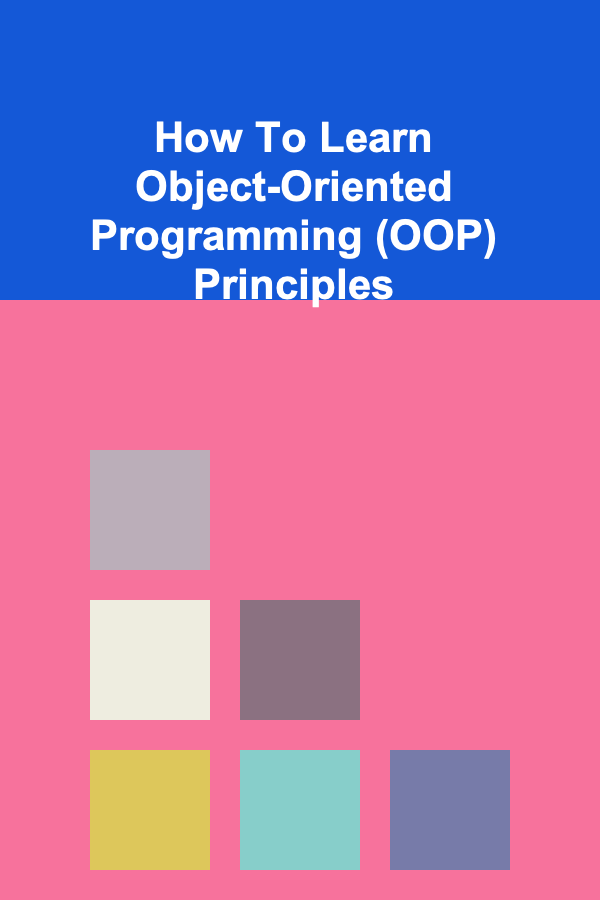
How To Learn Object-Oriented Programming (OOP) Principles
ebook include PDF & Audio bundle (Micro Guide)
$12.99$6.99
Limited Time Offer! Order within the next:

Object-Oriented Programming (OOP) is one of the most fundamental paradigms in modern software development. It focuses on organizing software into objects, which are instances of classes. This paradigm helps in making code more modular, reusable, and easier to maintain. Learning OOP principles is essential for any programmer who wishes to build scalable, maintainable, and efficient software systems. In this article, we will dive deep into the key principles of OOP, explore practical strategies for learning OOP, and provide tips on how to effectively master these concepts.
What Is Object-Oriented Programming?
Object-Oriented Programming (OOP) is a programming paradigm that organizes and structures software around objects rather than functions or logic. An object can be understood as a self-contained unit that contains both data (attributes) and behavior (methods). The key concepts that make up the foundation of OOP are classes, objects, inheritance, encapsulation, polymorphism, and abstraction.
OOP allows developers to structure their code in a way that models real-world systems more naturally, making it easier to design, develop, and maintain software.
The Core Principles of OOP
The key principles that form the foundation of OOP are:
- Encapsulation
- Abstraction
- Inheritance
- Polymorphism
Let's explore these principles in more detail.
1. Encapsulation
Encapsulation is the concept of bundling the data (attributes) and methods (functions) that operate on the data into a single unit known as a class. It restricts direct access to some of an object's components, which can help protect the object's internal state from unintended interference and misuse.
In simpler terms, encapsulation hides the internal details of an object and only exposes the essential features to the outside world. This is typically achieved using access modifiers such as private, protected, and public in most object-oriented languages.
Example:
Consider a Car class that encapsulates the details about a car's speed.
def __init__(self):
self.__speed = 0 # private attribute
def accelerate(self, increment):
self.__speed += increment
def get_speed(self):
return self.__speed
In this example, the __speed attribute is encapsulated and cannot be accessed directly from outside the class. The only way to modify or retrieve the speed is through the accelerate and get_speed methods, ensuring that the object's internal state remains consistent.
2. Abstraction
Abstraction involves simplifying complex systems by exposing only the essential details and hiding unnecessary complexity. The purpose of abstraction is to make software easier to understand and work with by focusing on high-level operations while hiding low-level details.
Abstraction is achieved through abstract classes or interfaces that define the structure of methods without implementing them. This allows developers to create classes that implement these abstract methods according to their specific needs.
Example:
Suppose you have a Shape class, and you want to create different types of shapes like Circle and Rectangle. The Shape class would be abstract, and each subclass would implement its specific details.
class Shape(ABC):
@abstractmethod
def area(self):
pass
class Circle(Shape):
def __init__(self, radius):
self.radius = radius
def area(self):
return 3.14 * (self.radius ** 2)
class Rectangle(Shape):
def __init__(self, width, height):
self.width = width
self.height = height
def area(self):
return self.width * self.height
Here, the Shape class is abstract, and the Circle and Rectangle classes provide concrete implementations of the area method. This hides the details of how area is calculated for each shape, providing a clean interface for clients to use.
3. Inheritance
Inheritance is a mechanism that allows one class to inherit properties and behaviors (methods) from another class. This promotes code reusability and the creation of hierarchical relationships between classes. Inheritance allows a subclass to take on the functionality of a parent class while adding or modifying behavior as needed.
Example:
Consider a Vehicle class that has common properties such as speed and fuel. Then, you can create specific subclasses like Car and Bike, which inherit the properties of Vehicle.
def __init__(self, speed, fuel):
self.speed = speed
self.fuel = fuel
def move(self):
print(f"Moving at {self.speed} km/h.")
class Car(Vehicle):
def __init__(self, speed, fuel, doors):
super().__init__(speed, fuel)
self.doors = doors
def honk(self):
print("Beep beep!")
class Bike(Vehicle):
def __init__(self, speed, fuel, type_of_bike):
super().__init__(speed, fuel)
self.type_of_bike = type_of_bike
def ring_bell(self):
print("Ring ring!")
In this case, both Car and Bike inherit the move method from the Vehicle class but also have additional methods that are specific to them (honk for Car and ring_bell for Bike).
4. Polymorphism
Polymorphism is the ability to use a single interface to represent different underlying forms (data types). In OOP, polymorphism allows you to treat objects of different classes in a uniform way. There are two types of polymorphism:
- Compile-time polymorphism (method overloading and operator overloading).
- Run-time polymorphism (method overriding).
Example:
In the context of shapes, you could call the area method on any Shape object, regardless of whether it's a Circle or a Rectangle, and the correct implementation will be invoked.
for shape in shapes:
print(f"Area: {shape.area()}")
Here, even though shapes contains both Circle and Rectangle objects, the appropriate area method for each shape will be called, demonstrating polymorphism.
How To Learn Object-Oriented Programming Principles
Now that we understand the core principles of OOP, let's dive into how to learn and master these concepts. Mastery of OOP requires time, practice, and a systematic approach. Below are some effective steps to learn OOP principles:
1. Learn the Basics of a Programming Language
Before diving into OOP, it's important to have a solid understanding of a programming language that supports object-oriented features. Some of the most popular languages for learning OOP include Python, Java, C++, and C#. Choose one language and become familiar with its syntax, variables, data structures, and basic control flow.
2. Start with Simple Examples
Begin with simple examples to grasp each of the OOP principles. Start by creating basic classes and objects. Understand how to define classes, create instances, and use methods. Once you're comfortable with the basic syntax and concepts, move on to more complex structures.
For example, start by building a class for a Person and adding methods such as greet or celebrate_birthday. Then, extend it by creating subclasses like Student or Employee.
3. Explore Real-World Applications
One of the best ways to understand OOP is by modeling real-world entities. Think about how objects in the real world could be modeled as classes and how they might interact with each other. For example, you could model a system for managing a library with classes like Book, Library, Member, and Loan.
4. Implement All Four OOP Principles
Try to implement all four principles in your projects:
- Encapsulation: Use private and public methods to protect data.
- Abstraction: Create abstract classes and interfaces where necessary.
- Inheritance: Create a class hierarchy where subclasses inherit from parent classes.
- Polymorphism: Use method overriding or interfaces to achieve polymorphism.
Building projects that require you to use all these principles will help reinforce your understanding.
5. Study Design Patterns
Once you're comfortable with the basic OOP principles, study design patterns. Design patterns are common solutions to recurring problems in software design. Patterns like Singleton, Factory, and Observer are commonly used in object-oriented design and can help improve the quality and maintainability of your code.
6. Write and Refactor Code
One of the most effective ways to learn OOP is through hands-on coding. Write as much code as possible and continually refactor it to make it more efficient and object-oriented. Over time, you'll gain a deeper understanding of how to properly structure and organize your code.
7. Participate in Code Reviews
Engage in code reviews with other developers. Reviewing other people's code can provide insights into how they implement OOP principles, and they can help you spot potential issues or improvements in your code.
8. Learn from Examples
Explore open-source projects or read code written by experienced developers. Pay attention to how they structure their code and implement OOP principles. This can expose you to better practices and new techniques.
Conclusion
Learning Object-Oriented Programming is a journey that requires both theory and practice. By understanding and applying the core principles of OOP---encapsulation, abstraction, inheritance, and polymorphism---you will be able to write more efficient, maintainable, and scalable code. Take your time, build small projects, and gradually tackle more complex problems as you gain confidence with OOP.

Creating a Passive Income Stream with Deep Learning in E-commerce
Read More
How to Plan for a Clutter-Free Life After Retirement
Read More
How to Use a Pegboard to Maximize Craft Room Space
Read More
How To Protect Your Online Reputation and Privacy
Read More
How To Master 3D Printing for Home Decor
Read More
10 Productivity Hacks for Your Language Learning To-Do List
Read MoreOther Products

Creating a Passive Income Stream with Deep Learning in E-commerce
Read More
How to Plan for a Clutter-Free Life After Retirement
Read More
How to Use a Pegboard to Maximize Craft Room Space
Read More
How To Protect Your Online Reputation and Privacy
Read More
How To Master 3D Printing for Home Decor
Read More